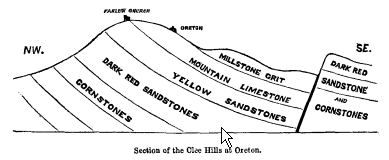No CrossRef data available.
Article contents
On The Lower Carboniferous Beds of the Clee Hills
Published online by Cambridge University Press: 17 March 2016
Extract
Perhaps in all the physical geology of England there is nothing finer than the erupted heights of the Clee. Encircled by the typical “Old Red”—a wide-stretching tract of alternating sandy shores and gravel-beaches of that period—are the characteristic beds of the coal-measures, lying upon Millstone Grit and Mountain Limestone.
Of the causes that have elevated these deposits into the hills of Titterstone and the Brown Clee I need not speak—their basaltic summits, where the erupted rock has assumed a rude columnar form after cooling, are sufficient evidence; but I would direct especial attention to that group of beds whose strike is along the Oreton ridge, and whose chief member, the Mountain Limestone, forms its axial line. This lies midway between the two hills; its southern side slopes down the “Common,” and is composed of Millstone Grit, cut off abruptly by a long line of fault, the effect of which has been to have depressed that deposit into a valley, and to have raised the underlying “Old Red” into a nearly continuous line of cliff. The accompanying section will better describe their relative positions.

These Millstone Grits are non-fossiliferous; but the mineralogist may detect in their conglomerated structure many pebbles of a high class, jaspers and cornelians of pure quality being often met with. These beds lead up to the Mountain Limestone, which contains a fine series of organic remains, such as palatal teeth of the Cestraciont fishes. Petalodus Hastingsii and Psammodus porosus are abundant; yet, although fragments of their jaws are not uncommon, I have only met with one specimen having the teeth in their true position.
- Type
- Research Article
- Information
- Copyright
- Copyright © Cambridge University Press 1858




